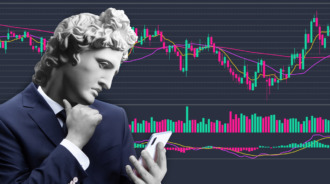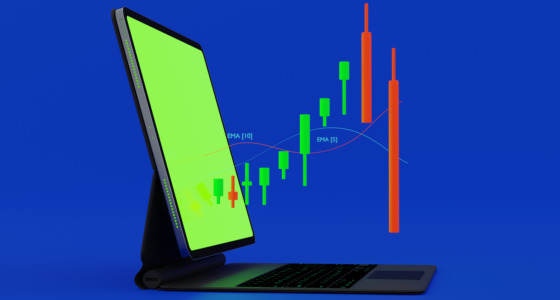

Every trader dreams of a simple but effective tool for getting returns. Start with moving averages (MA)!
The moving average is one of the most popular indicators in technical analysis. Being a trend indicator, MA helps define the beginning and end of a new trend. There are several types of moving averages that differ in calculation approaches. Each type of MA has its own set of strong and weak features.
Definition and types of moving averages
There are several types of moving averages. They differ in the method of calculation and sensitivity to price changes.
The average is called “moving” because it’s formed on the chart bar by bar and forms a line that moves along the chart.
- Simple moving average (SMA). This is the arithmetic mean of prices over a certain period of time (average price). It’s the simplest and slowest MA.
- Exponential moving average (EMA) and Weighted moving average (WMA). These MAs are combined, as their formulas are similar. The calculation is based on historical price values. Due to this, the newer the quotes, the higher their role. Both EMA and WMA make recent data more important for calculations that apply special coefficients. Therefore, they are more sensitive to price changes than the simple moving average. But the EMA gives weights to the latest prices in an exponential way, while, for WMA, relative weights of each price form an arithmetic progression. That’s why the EMA is even faster than the WMA.
There are three 21-period moving averages applied to close prices on the chart. The yellow MA is simple, the red MA is exponential, and the green MA is weighted. The difference between them is small enough, and for shorter periods, it may be hardly noticed — yet it’s evident that weighted MA is the most sensitive. Traders usually prefer to deal with exponential moving averages for shorter periods and simple moving averages for longer periods.
How to implement moving averages
The most important parameter of a moving average is its period. The larger it is, the more price fluctuations are smoothed out. The most common large periods are 50, 100, and 200. The shorter the period is, the more it reacts to price changes. Usually, traders use 9, 12, and 21 periods for small timeframes. Now, you’ll learn how to build a moving average trading strategy.
Break of a moving average
That’s the most simple moving average trading strategy. If the price breaks a moving average upwards and consolidates above the MA, it’s a signal to open a long position. Exit the position as soon as the price breaks the moving average downwards. If the price stays below the MA, it’s a signal to sell, and now MA becomes the line of resistance. There is a red 21-period MA based on close prices on the chart. Arrows indicate new positions, and crosses indicate their closes.
An intersection of two moving averages
This method is usually based on two moving averages of one type but with different periods. One of them must have a longer period (such a MA is also called “slow”), the other with a smaller period (such a MA is called “fast”). The signal for opening a position is an intersection of moving averages. When the fast MA crosses the slow MA upwards then there is a signal to buy. On the contrary, when the fast MA crosses the slow MA downwards, that’s a signal to sell.
Here is the same part of the graph as in the previous picture, but there is a new MA: the yellow 9-period SMA based on close prices. The sell position is opened at the next bar after the first intersection: the fast 9-period SMA crosses the slow 21-period SMA downwards. The close point is the next bar after the second intersection, but this time, the fast SMA crosses the slow SMA upwards. This signal also means a new buy position.

The main advantages and disadvantages of moving averages
As you can see, the second trade is also profitable, but the value of profit is less in comparison with the previous case. The reason is pretty simple. The first strategy uses only one MA, and the second data sequence is the price chart. For the second strategy, there is the 9-period MA instead of the price itself. But any MA is a lagging indicator. So, a part of the price movements will be lost, leading to losses.
At first glance, it’s not a good idea to use MA intersections in trading, but that’s not actually the case. The main idea of MA is smoothing. It helps to exclude as many false breakthroughs as possible. That’s the main advantage of MA: it helps to trade in trending markets.
There are two opposite tendencies: a too-short period of averaging leads to a great number of false signals while a too-long period lacks the speed of reaction. That’s why small periods are used for short-term trading, while long periods are applied when trading on long timeframes.
Also, MA ideology isn’t suitable for the flat market at all. You need some additional criteria for trend detection. Generally, there are two basic options for more effective usage of MAs:
- Using oscillators along with MAs;
- Avoiding too-short time periods, from 1 to 30 minutes, preferring to deal with relatively clear trends.
To conclude
As noted above, MA is one of the main indicators for technical analysis. It is also the best indicator in terms of simplicity and visuality. However, MA has a significant drawback: it is a lagging indicator. Therefore, successful day trading moving averages strategies require using special trading approaches like sets of moving averages with different periods or types. Another solution is to use additional indicators, such as oscillators, along with moving averages.








